Ben Niu
Training Data Attribution: Was Your Model Secretly Trained On Data Created By Mine?
Sep 24, 2024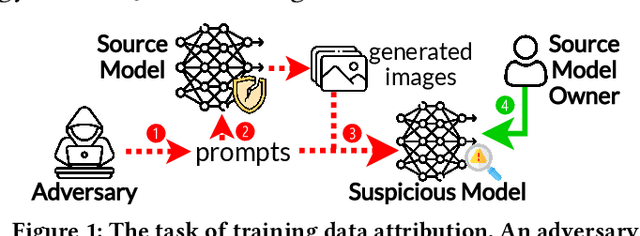
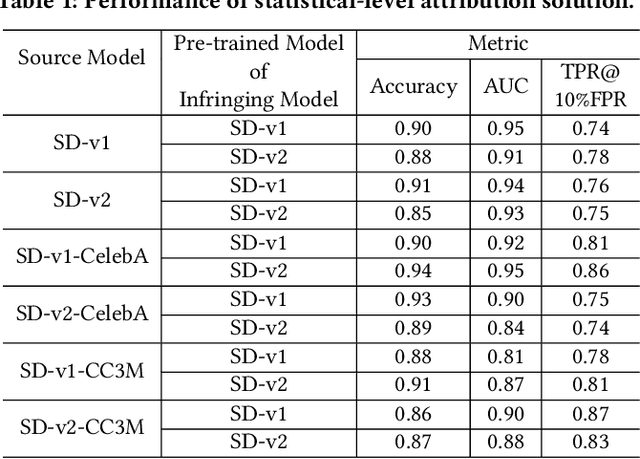
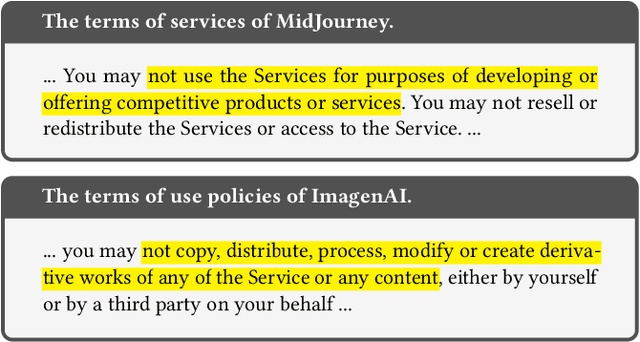

Abstract:The emergence of text-to-image models has recently sparked significant interest, but the attendant is a looming shadow of potential infringement by violating the user terms. Specifically, an adversary may exploit data created by a commercial model to train their own without proper authorization. To address such risk, it is crucial to investigate the attribution of a suspicious model's training data by determining whether its training data originates, wholly or partially, from a specific source model. To trace the generated data, existing methods require applying extra watermarks during either the training or inference phases of the source model. However, these methods are impractical for pre-trained models that have been released, especially when model owners lack security expertise. To tackle this challenge, we propose an injection-free training data attribution method for text-to-image models. It can identify whether a suspicious model's training data stems from a source model, without additional modifications on the source model. The crux of our method lies in the inherent memorization characteristic of text-to-image models. Our core insight is that the memorization of the training dataset is passed down through the data generated by the source model to the model trained on that data, making the source model and the infringing model exhibit consistent behaviors on specific samples. Therefore, our approach involves developing algorithms to uncover these distinct samples and using them as inherent watermarks to verify if a suspicious model originates from the source model. Our experiments demonstrate that our method achieves an accuracy of over 80\% in identifying the source of a suspicious model's training data, without interfering the original training or generation process of the source model.
Bypassing DARCY Defense: Indistinguishable Universal Adversarial Triggers
Sep 05, 2024Abstract:Neural networks (NN) classification models for Natural Language Processing (NLP) are vulnerable to the Universal Adversarial Triggers (UAT) attack that triggers a model to produce a specific prediction for any input. DARCY borrows the "honeypot" concept to bait multiple trapdoors, effectively detecting the adversarial examples generated by UAT. Unfortunately, we find a new UAT generation method, called IndisUAT, which produces triggers (i.e., tokens) and uses them to craft adversarial examples whose feature distribution is indistinguishable from that of the benign examples in a randomly-chosen category at the detection layer of DARCY. The produced adversarial examples incur the maximal loss of predicting results in the DARCY-protected models. Meanwhile, the produced triggers are effective in black-box models for text generation, text inference, and reading comprehension. Finally, the evaluation results under NN models for NLP tasks indicate that the IndisUAT method can effectively circumvent DARCY and penetrate other defenses. For example, IndisUAT can reduce the true positive rate of DARCY's detection by at least 40.8% and 90.6%, and drop the accuracy by at least 33.3% and 51.6% in the RNN and CNN models, respectively. IndisUAT reduces the accuracy of the BERT's adversarial defense model by at least 34.0%, and makes the GPT-2 language model spew racist outputs even when conditioned on non-racial context.
Exploring User Acceptance Of Portable Intelligent Personal Assistants: A Hybrid Approach Using PLS-SEM And fsQCA
Aug 30, 2024Abstract:This research explores the factors driving user acceptance of Rabbit R1, a newly developed portable intelligent personal assistant (PIPA) that aims to redefine user interaction and control. The study extends the technology acceptance model (TAM) by incorporating artificial intelligence-specific factors (conversational intelligence, task intelligence, and perceived naturalness), user interface design factors (simplicity in information design and visual aesthetics), and user acceptance and loyalty. Using a purposive sampling method, we gathered data from 824 users in the US and analyzed the sample through partial least squares structural equation modeling (PLS-SEM) and fuzzy set qualitative comparative analysis (fsQCA). The findings reveal that all hypothesized relationships, including both direct and indirect effects, are supported. Additionally, fsQCA supports the PLS-SEM findings and identifies three configurations leading to high and low user acceptance. This research enriches the literature and provides valuable insights for system designers and marketers of PIPAs, guiding strategic decisions to foster widespread adoption and long-term engagement.
Factors Influencing User Willingness To Use SORA
May 07, 2024Abstract:Sora promises to redefine the way visual content is created. Despite its numerous forecasted benefits, the drivers of user willingness to use the text-to-video (T2V) model are unknown. This study extends the extended unified theory of acceptance and use of technology (UTAUT2) with perceived realism and novelty value. Using a purposive sampling method, we collected data from 940 respondents in the US and analyzed the sample using covariance-based structural equation modeling and fuzzy set qualitative comparative analysis (fsQCA). The findings reveal that all hypothesized relationships are supported, with perceived realism emerging as the most influential driver, followed by novelty value. Moreover, fsQCA identifies five configurations leading to high and low willingness to use, and the model demonstrates high predictive validity, contributing to theory advancement. Our study provides valuable insights for developers and marketers, offering guidance for strategic decisions to promote the widespread adoption of T2V models.
Patient Dropout Prediction in Virtual Health: A Multimodal Dynamic Knowledge Graph and Text Mining Approach
Jun 07, 2023Abstract:Virtual health has been acclaimed as a transformative force in healthcare delivery. Yet, its dropout issue is critical that leads to poor health outcomes, increased health, societal, and economic costs. Timely prediction of patient dropout enables stakeholders to take proactive steps to address patients' concerns, potentially improving retention rates. In virtual health, the information asymmetries inherent in its delivery format, between different stakeholders, and across different healthcare delivery systems hinder the performance of existing predictive methods. To resolve those information asymmetries, we propose a Multimodal Dynamic Knowledge-driven Dropout Prediction (MDKDP) framework that learns implicit and explicit knowledge from doctor-patient dialogues and the dynamic and complex networks of various stakeholders in both online and offline healthcare delivery systems. We evaluate MDKDP by partnering with one of the largest virtual health platforms in China. MDKDP improves the F1-score by 3.26 percentage points relative to the best benchmark. Comprehensive robustness analyses show that integrating stakeholder attributes, knowledge dynamics, and compact bilinear pooling significantly improves the performance. Our work provides significant implications for healthcare IT by revealing the value of mining relations and knowledge across different service modalities. Practically, MDKDP offers a novel design artifact for virtual health platforms in patient dropout management.
Single Image Super-Resolution via a Holistic Attention Network
Aug 20, 2020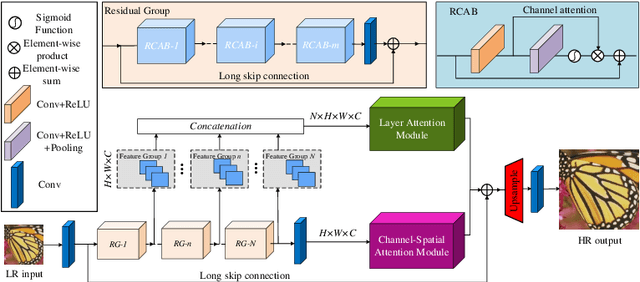



Abstract:Informative features play a crucial role in the single image super-resolution task. Channel attention has been demonstrated to be effective for preserving information-rich features in each layer. However, channel attention treats each convolution layer as a separate process that misses the correlation among different layers. To address this problem, we propose a new holistic attention network (HAN), which consists of a layer attention module (LAM) and a channel-spatial attention module (CSAM), to model the holistic interdependencies among layers, channels, and positions. Specifically, the proposed LAM adaptively emphasizes hierarchical features by considering correlations among layers. Meanwhile, CSAM learns the confidence at all the positions of each channel to selectively capture more informative features. Extensive experiments demonstrate that the proposed HAN performs favorably against the state-of-the-art single image super-resolution approaches.
Input Perturbation: A New Paradigm between Central and Local Differential Privacy
Feb 20, 2020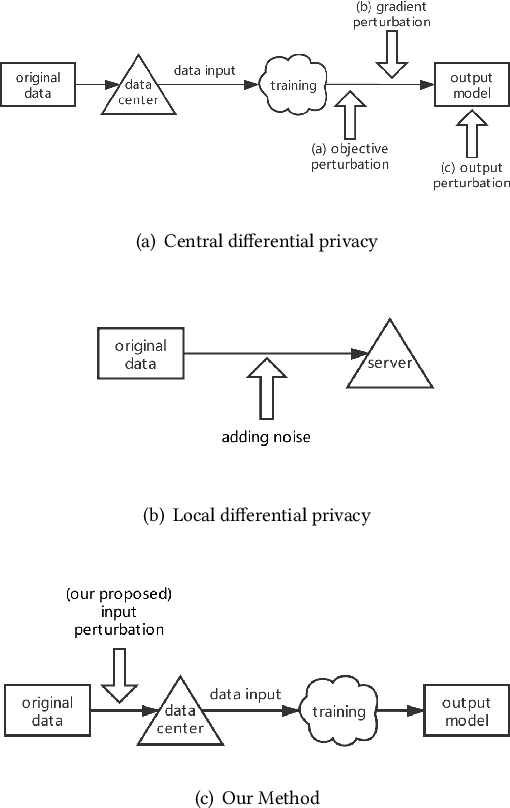
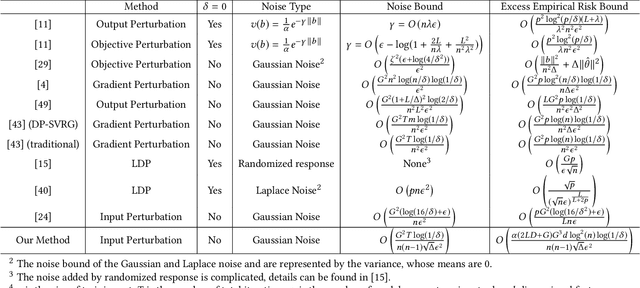
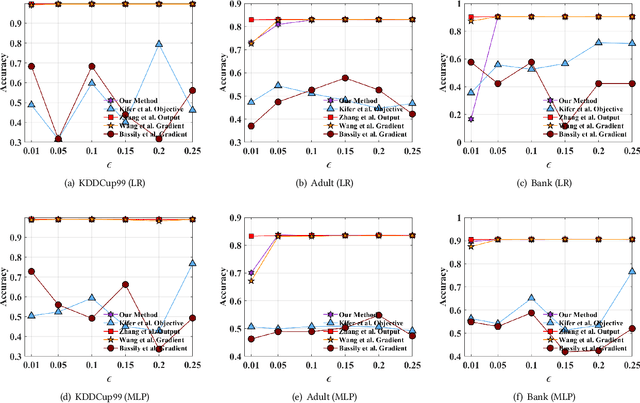
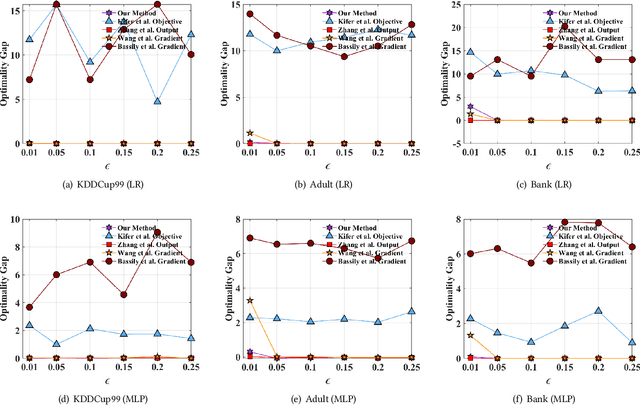
Abstract:Traditionally, there are two models on differential privacy: the central model and the local model. The central model focuses on the machine learning model and the local model focuses on the training data. In this paper, we study the \textit{input perturbation} method in differentially private empirical risk minimization (DP-ERM), preserving privacy of the central model. By adding noise to the original training data and training with the `perturbed data', we achieve ($\epsilon$,$\delta$)-differential privacy on the final model, along with some kind of privacy on the original data. We observe that there is an interesting connection between the local model and the central model: the perturbation on the original data causes the perturbation on the gradient, and finally the model parameters. This observation means that our method builds a bridge between local and central model, protecting the data, the gradient and the model simultaneously, which is more superior than previous central methods. Detailed theoretical analysis and experiments show that our method achieves almost the same (or even better) performance as some of the best previous central methods with more protections on privacy, which is an attractive result. Moreover, we extend our method to a more general case: the loss function satisfies the Polyak-Lojasiewicz condition, which is more general than strong convexity, the constraint on the loss function in most previous work.
 Add to Chrome
Add to Chrome Add to Firefox
Add to Firefox Add to Edge
Add to Edge